Table of contents
- Vincent collector Kurt Schupp Lightning and Thunder – Gray Flash and Black Lightning
- These engines are very powerful
- Waiting for the first Vincent
- Around 80 NSUs
- Tank emblems were often forged
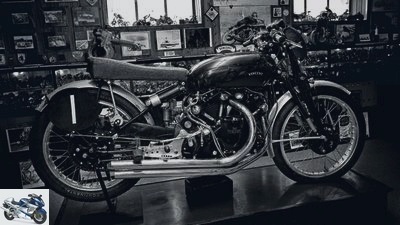
Osterling
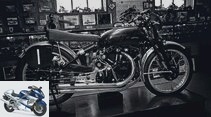
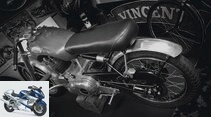
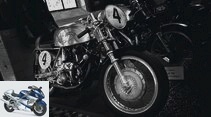
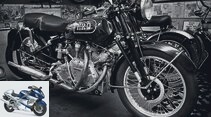
11 pictures
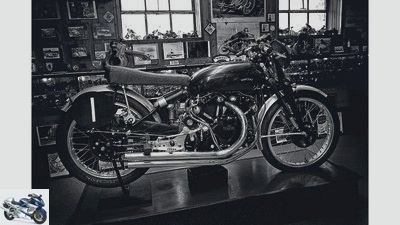
Osterling
1/11
Kurt Schupp’s Vincent collection includes a number of wonderfully preserved specimens.
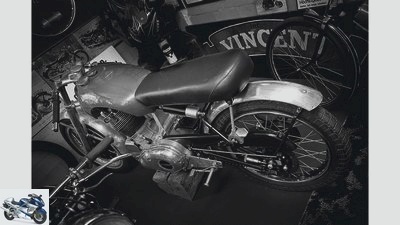
Osterling
2/11
Also a perch from Schupp’s collection.
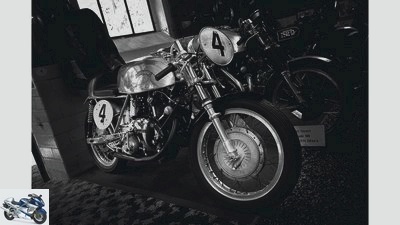
Osterling
3/11
A Vincent Egli.
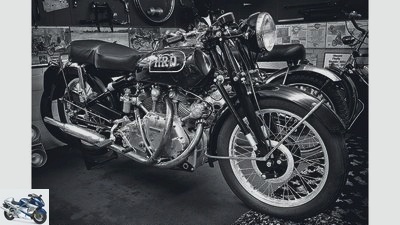
Osterling
4/11
Schupp also hoards old HRD, as the brand was called before Phil Vincent bought it.

Osterling
5/11
Phil Vincent once worked on this drawing board.
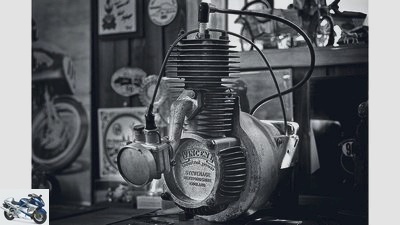
Osterling
6/11
There were even tests with stationary engines.
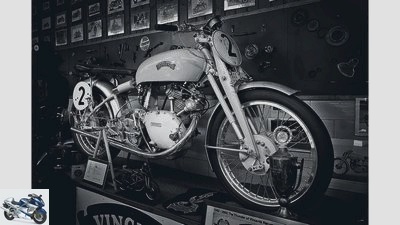
Osterling
7/11
The lesser known 500 Gray Flash has a similar status to the 1000 Black Lightning.
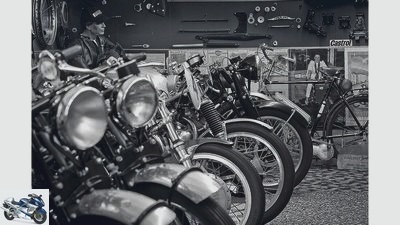
Osterling
8/11
Vincent was always the breeding ground for all kinds of fairy tales and legends.
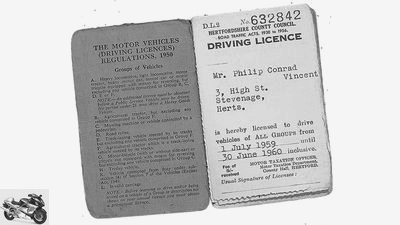
Osterling
9/11
Phil Vincent’s widow even entrusted the avid collector with her husband’s original driver’s license.
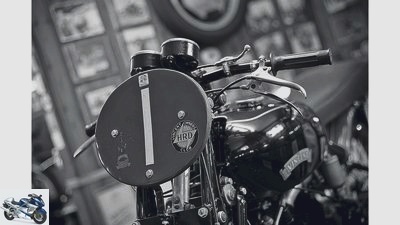
Osterling
10/11
From Kurt Schupp’s Vincent Collection.
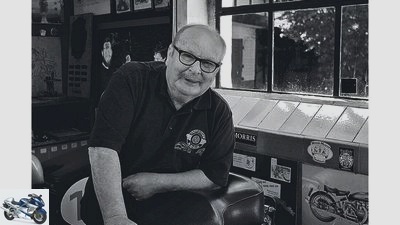
Osterling
11/11
Collector Kurt Schupp lives in his Vincent world.
Sports & scene
Scene: Vincent Collector
Vincent collector Kurt Schupp
Lightning and Thunder – Gray Flash and Black Lightning
Content of
Whether it’s Gray Flash or the extremely rare Black Lightning – collector Kurt Schupp fell victim to the Vincent virus and has acquired numerous valuable, squeaky clean treasures from the British manufacturer over the decades.
Jan Leek
11/28/2012
The Second World War ended in 1945, when Kurt Schupp was 13. At 16, real life seemed to begin for him. “The first magazines appeared, some only as sample copies, but there were motorbikes in them, paradise for some of us. Then the first exhibitions followed, Earls Court, Milan and Paris, and I saw a picture of a Vincent for the first time in a little booklet from the motor show in Paris. ” It was the beginning of a passion, but the 16-year-old didn’t know that it would develop into a lifelong passion. Not even that he is the proud owner of one twelve years later Vincent should be his first. Kurt completed an apprenticeship as an electrician, then switched to business, but the interest in motorcycles was always present. “Some motorcycles are fondly remembered and some are more forgotten. Papa’s motorcycle was an early acquaintance, an Imme 100. I remember them fondly, ”says Schupp.
These engines are very powerful
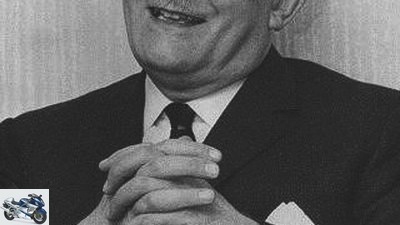
archive
Philip Vincent.
These engines are very powerful. Period. In addition, the motorcycles are simply bursting with technical solutions that can still be considered progressive today. The seating position can be tailored through a sensible arrangement of the footrests. Even the gear lever is adjustable in length. The rear wheel usually has two chainrings – before the first inclines in the Alps, you simply turn the wheel around for a shorter gear ratio, in principle without tools. The frame itself actually only consists of an oil tank with an integrated steering head and the two upper engine mountings. The two rear fixed points also serve as the basis for the entire rear suspension and here the whole motorcycle can be split in half if necessary.
Such technical finesse, especially the overall result, is the breeding ground for all kinds of wild stories and fairy tales, not just the one about Rollie Free in swimming trunks, stretched out on his Vincent for a new record, which can now be seen on countless T-shirts as a motif. Another fairy tale is the birth of the V-twin cylinder. The single-cylinder already existed, but one evening two drawings of the engine were lying diagonally one above the other, and the designer Phil Irving saw the future in front of him. Nobody could have suspected that a legendary engine was born almost at that moment.
Waiting for the first Vincent
“Later, in 1958, at the elephant meeting I stood next to a Vincent for three hours and waited for its English owner. In vain. I didn’t know then how much beer English people could drink – it just didn’t show up. A year later I saw the first Vincent with a German registration. ” These were two milestones in his life. Vincent emerged from the old HRD brand, which the young Phil Vincent bought with money from his wealthy father before the war, later a Phil joined it, the talented Australian designer Phil Irving.
Vincent had and still has a very special charisma, as a single-cylinder 500, but above all in the 1000 two-cylinder version. The glorious V2 drove countless record-breaking machines. The turning point in Kurt’s life came in 1960 with three classified ads in MOTORRAD. In one issue, three Vincent were suddenly offered for sale, one in Bad Homburg, one in Switzerland and one in Berlin. But the one in Berlin was a Black Lightning! The racing machine, the holy grail in Vincenttum, was a real treasure for anyone who lost their heart to the mighty engines from Stevenage.
Around 80 NSUs
“You have to know that in the first few years only five Vincent were sold in Germany when Switzerland was importing lots of Vincent at the same time. And now five years had passed since the brand stopped producing the motorcycles. There weren’t any new ones! I thought it was my turn, immediately went to the bank and sent a telegram to the clerk. I then flew to Berlin with the last of my money to take the treasure home, ”reports Schupp. According to the factory, 16 Black Lightning were produced, but later information shows that one more was started in the final phase in 1955. Enthusiasts now speak of 16.5.
Kurt Schupp’s career got off to a flying start with this Black Lightning. Today Kurt lives in, let’s say, a large warehouse in the middle of the cozy village of Niederwetz, not far from Wetzlar. On the upper floors there is the living area with half-timbering and rough roof beams, tastefully but not excessively large, as there is a small collection with various motorcycles and advertising material, signs, tools and machines directly on the other side of the well-stocked bookcase.
“Since Vincent was looking for a cooperation with NSU, I also got on this track and that’s why there are around 80 NSUs here, including the bikes maybe even 90.” On the lower floor there are 14 complete Vincent models in all conceivable variants up to the glorious, single-cylinder 500 Gray Flash and, in a separate room, Kurt’s first Vincent, the Black Lightning. But how did it come about? Where do all these Vincent come from and do they have to be so many? Kurt spreads his arms and shrugs his shoulders: “My God, the opportunity is coming, the machine is good and … oh, I don’t know!”
Kurt’s whole life seems to be centered around the Vincent brand here. Over time, a “German Section” of the Vincent Owners’ Club was formed with Kurt at the forefront, and this section quickly became important in Great Britain as well. The first meeting on German soil took place in 1973 and attracted 30 participants, in 1987 there were already 630. Vincent’s place in the history of the motorcycle was always special, perhaps because the engine was so often used as a drive for all kinds of projects. The performance was astronomical for the conditions at the time, you didn’t even have to put a figure.
Tank emblems were often forged
A legend also tells that the tank emblems of the early Vincent HRD were often forged in the USA by removing the “R”. Simply calling the machine Vincent solved the problem. Incidentally, John Surtees, who later became a motorcycle and even Formula 1 world champion, and was the only one who has managed this feat so far, served as an apprentice at the Vincent plant in Stevenage for a long time. One of Surtees ‘favorite pieces in his own collection is still his old Gray Flash.
Of course, Kurt Schupp also has a Gray Flash in his collection. In addition to this 500, it is of course the Black Lightning that is the crown of the collection, even if you can hardly believe at first that a Black Lightning is at home in Niederwetz. Incidentally, Kurt himself calls the machine “the Berliner”.
Related articles
-
Scene: Portrait of Ferry Brouwer
Siemer Sports & scene Scene: Portrait of Ferry Brouwer Scene: Portrait of Ferry Brouwer To ask! Content of He was a mechanic for greats like Phil Read…
-
Portrait of US collector Fred Mork
Blacksmith 27 pictures Blacksmith 1/27 The similarity between human and … Blacksmith 2/27 Blacksmith 3/27 Tons of story (s): whether model kits,…
-
Portrait of motorcycle collector Wolfgang Lindfeld
Fred Siemer 9 pictures Fred Siemer 1/9 At the collector Wolfgang Linfeld Fred Siemer 2/9 Best of show: The Turbo-Suzuki XN 85 was built from 1983 to 1985…
-
Portrait of racing machine collector Wolfhart Krischke
Fred Siemer 14th pictures Fred Siemer 1/14 Wolfhart Krischke’s racing machine collection. Fred Siemer 2/14 King with BMW gearbox and cardan. Fred Siemer…
-
Horex 23 pictures Horex 1/23 Horex 6-cylinder motorcycle: working on the model of the cylinder head. Horex 2/23 Horex 6-cylinder motorcycle: the red…
-
Ducati 50 SL-1: the rare collector’s item offers classic shapes and beautiful details
Bilski 16 pictures Bilski 1/16 Ducati’s 50s two-stroke with cross-flow purging makes 4.5 hp, which, according to the factory, should be enough for around…
-
Blacksmith Sports & scene Motorsport Motorcycle scene: Hamburg Motorcycle scene: Hamburg Lively scene in the Hanseatic city Not only Udo Lindenberg feels…
-
Scene: Review: 26 years of Buell – Erik Buell remembers
Cathcart 55 pictures Buell 1/55 Erik Buell and the Rotax team at the Rotax plant. Buell 2/55 2003 – Stuntman Craig Jones on an XB9S. Buell 3/55 The Buell…
-
World record attempt with Vincent
Schermer Sports & scene Motorsport World record attempt with Vincent Scene: World record attempt with Vincent Hartmut’s Speed Date Content of There are…
-
Scene: Portrait of two-stroke fan Scherubl
Siemer 15th pictures Siemer 1/15 The two-stroke fan Gunter Scheruebl transforms old series motorcycles into racing replicas. Siemer 2/15 Scherubl can…